

Volume 3, No. 2, Art. 17 – May 2002
Picture the Practice—Using Photography to Explore Use of Technology Within Teachers' Work Practices
Anne Marie Kanstrup
Abstract: This article describes photography as a means for data collection and analysis in a workplace study on the use of technology within teachers' work practices. Examples of visual technology applications within workplace studies are outlined and the source of inspiration behind the use of photography in this particular workplace study is described. With a point of departure in stories from the study at hand, the experiences from photography for both data collection and analysis appear. The article concludes with reflections on both the empirical and the methodological results.
Key words: photography, work practice, technology, teachers, collaborative analysis
Table of Contents
1. Introduction
1.1 The use of visual technologies within workplace studies
1.2 Using collaboration to challenge imageries
2. Source of Inspiration for the Use of Photography
3. Photographical Observations—Field Experiences
3.1 Using photography for data collection
3.2 Using photography for collaboration in interviews
4. Picturing the Practice—Collaborative Analysis
4.1 Work practices
4.1.1 Social spaces in the work practices of teachers
4.1.2 Performance control at the social stages
4.2 Technology
4.2.1 Making the technology visible
4.2.2 Taking a closer look at the use of technology
4.2.3 Identifying premises between teachers and technology
4.3 Reflections on visibility
5. Conclusions
This article describes photography as a means for data collection and analysis in a workplace study on the use of technology within teachers' work practices. The study at hand takes place in North Jutland in Denmark. In 2001 this area was granted funds by the Danish government for experimentation with technology and enhancement of technological education and competencies among the entire population (see http://www.detdigitalenordjylland.dk). Consequently, many experiments have started in several different types of work places in the region, including 15 projects using technology in teachers' work practices which are the subject of this study. These 15 projects are not necessarily high-tech experiments but rather experiments with integration of technology in the teachers' work practices, either through use of technologies in ordinary classroom teaching or through use of virtual learning systems. The projects entail experiments in the Danish county schools, high schools, universities and institutions for the disabled. [1]
The study described in this article is the first step into the field. It is a preliminary study that lasted over three months. The aim was to obtain an overview and from this general impression open the way for further and more specific investigations. This interest in a general overview led to observations of all 15 projects experimenting with technology in the work practices of teachers. Each of the 15 observations had a duration of one working day and the method was to observe, by following, one teacher during his/her working day. This involved meeting the teacher when s/he arrived at work and following the teacher through the daily work activities. The observations were concluded when the teacher went home or had work activities that they felt were difficult for me to participate in e.g. staff meetings, preparations at home, parents' meetings, etc. Data were collected through both field notes and photographs on the observed situations, and qualitative interviews about the practices that I was not able to observe. Photographs were taken only in agreement with the teachers and students who were informed that the photographs would be used for academic publishing. In some institutions, mostly institutions for the disabled, I was not allowed to take photographs because of patient (student) confidentiality. As a consequence, these institutions are not represented in the photographic study described in this article. [2]
1.1 The use of visual technologies within workplace studies
Methodologically, it can be difficult to understand work practices since parts of work practices may even be invisible at first hand, if not to ourselves then to others (STAR & STRAUSS 1999). Understanding work practices consequently means taking a closer look at what people within the work practices actually do. This need for closer investigation has made researchers within work place studies turn to ethnographic methods and to the use of visual technologies in data collection and analysis. In this connection, the use of video as a technology for data collection and analysis is often applied (HEATH & LUFF 2000; LUFF, HINDMARSH & HEATH; GOODWIN & GOODWIN 1998; SUCHMAN 1998; RUHLEDER & JORDAN 1997; JORDAN 1993). Video has proven its strength within work place studies because video offers an opportunity to observe and re-observe complex work situations over and over again and in this way allow for a close study of how people accomplish their work. By recording and re-observing work situations, researchers may attain glimpses of the complex ongoing interaction in a work situation. [3]
As described above the study at hand is a preliminary study that took place over three months and aimed to establish an overview of 15 different projects involving teachers taking technology into use in their work practices. The rich visual and verbal data that video recordings deliver, calling for in-depth analysis of chosen work situations, seemed in this context to be a too time consuming technology to use for data collection and analysis. However, appreciating the opportunities that visual data offers work place studies, an experiment with the use of photography for data collection and analysis was attempted instead. Photographs are stills in contrast to the moving pictures of video recordings, they are only visual, not verbal, and leave us in that sense with less, or less complex, data. In this way photographs might give the opportunity to get a closer look at the studied work practices in a quicker way focusing on a general overview as needed in this study. [4]
1.2 Using collaboration to challenge imageries
As SUCHMAN points out, every overview or map of a work practice is made on the basis of different perspectives and interests, which leaves certain aspects in the foreground and others in the background (SUCHMAN 1995). The perspectives, or imageries as BECKER would call it (BECKER 1998, pp.10-66), used in this study are social spaces. The idea is, that a spatial overview can lead to not only an overview of the teachers' work practices but also of the spaces in which technology is applied within the work practices. In his studies of "The Presentation of Self in Everyday Life" GOFFMAN describes two types of social spaces (GOFFMAN 1959): the front stage which is defined as a place where "... a particular performance is or may be in progress" (p.110) and the back stage where "... action occurs that is related to the performance but inconsistent with the appearance fostered by the performance" (p.135). At first hand, these metaphors are transferable to the work practices of teachers. A teacher's front stage is represented as the classroom and other spaces where interaction of "particular performance" with students is taking place. A teacher's backstage is the spaces in which preparations are made, meetings with colleagues are held, etc.; in other words, actions which are "related to the performance but inconsistent with the appearance fostered by the performance." The question is, however, if this imagery of these two types of social spaces actually exist within the work practices of teachers and where technology comes in. Challenging this imagery of the work practices of teachers is, in other words, another reason for choosing photography for data collection and analysis. [5]
Photography, like other visual data, leaves an opportunity for collaboration around the data material with research colleagues or participants in the study which is an opportunity for challenging imageries and biases. While field notes are often regarded as personal and private documents, which are rarely shared with others (HAMMERSLEY & ATKINSON 1995, p.176), visual data like video and photography are easy to share and can be used for collaborative research. Video recordings are linear data leaving collaborators the opportunity to play, pause, rewind and from this discuss the data material in front of a TV with VCR (JORDAN & HENDERSON 1995, p.43). On the contrary photographs are single frames in paper material. They can be touched, rearranged and sorted out. We can hang them on a wall or put them on a table and in this way try to establish an overview as needed in this study. We can take the photographs with us to various places and in that way engage in dialogue at home or at work or wherever we find it appropriate (COLLIER & COLLIER 1986, pp.99-132). In this way, photographs are a very flexible type of data, leaving several possibilities for collaboration. [6]
2. Source of Inspiration for the Use of Photography
Within qualitative research, photographs are mostly applied in the fields of visual anthropology (HOCKINGS 1995; BANKS & MORPHY 1997) and visual sociology (HARPER 1994). Visual anthropology was the first field to experiment with the use of photography and film "in a discipline of words" (MEAD 1995). The use of photography for other reasons than mere illustration was initiated in the 1930s in BATESON and MEAD's field study presented in "Balinese Character: A Photographic Analysis" (BATESON & MEAD 1942). While the field of visual anthropology is mostly centered in the Third World and increasingly concerned with film and video, visual sociology has, since its start in the 1960s, been inspired by both visual anthropology but also by documentary photography on issues relevant to sociology (HARPER 1994). HARPER's study of "Skill and Community in a Small Shop" (HARPER 1987) is an example of how photographs can be used to observe work practices and engage in dialogue with the participants in a study. HARPER uses photographic observations in combination with field notes and qualitative interviews, a data triangulation which has inspired this study (cf. Section 1). [7]
The main source of inspiration to the use of photographs for observations and analysis is, however, found in the work of the two visual anthropologists COLLIER and COLLIER (1986). COLLIER and COLLIER show how photography can be used, not only for illustrations as it is often seen within anthropology and other research fields but, as a "research method", which means that photographs replace field notes as data for analysis and can be used as a medium for dialogue in interviews. In COLLIER and COLLIER's work photography is mostly used for overall surveys, for example in the beginning of research projects where the focus, as in this study, is on mapping the field (COLLIER & COLLIER 1986, pp.29-44). But also when the field experience increases the camera is used for sampling, for example "for inventorying" (COLLIER 1995, p.239), when photographing every house in a town, or more complex the interior in households. An example is JOHN COLLIER, JR.'s inventory study of Indians who came to the San Francisco Bay Area seeking employment. A photograph sample of all visible property within the migrants' homes showed "... how these migrants readjusted their styles to urban living" (1995, p.241). COLLIER and COLLIER's photography of sites or people creates overviews that can be used for questioning and thereby for further and more detailed investigations into the field because photographs, in contrast to words, are not definitive. The phrase "a picture is worth a thousand words" is visualized in COLLIER and COLLIER's photographs. They all reflect questions in the way that they stay open to interpretation. In this way COLLIER and COLLIER show how photography can be useful in a preliminary study like this focusing on getting an overview and open the way for further and more detailed investigations. This openness to interpretation leaves room for collaboration on the data material in the analytical phase. Both HARPER (1987) and COLLIER and COLLIER show how photography, with great value to the research, can be used in dialogue with the field through interviews (1986, pp.99-132). One of the values is, as mentioned in Section 1.2., that collaboration challenge imageries and biases, or as described by COLLIER and COLLIER "... when interview responses are studied against the photographs, overtones and circumstantial detail can be reevaluated ..." (1986, p.108). Another value is that the photographic data can in fact also be interpreted by the participants in the study as "... potential range of data enlarges beyond that contained in the photographs themselves" (COLLIER & COLLIER 1986, p.99). In this way, photographs can be used not only to engage in dialogue with the teachers in this study but also to look beyond the content of the photographs and further into the work practices of the teachers. [8]
Focusing on getting an overview of the work practices of teachers, using social spaces as imageries and wanting to challenge these imageries by collaborating around the visual data material (cf. Section 1), COLLIER and COLLIER's research inspired me to take photographs of social spaces within the work practices of teachers, and to start a collaborative analysis with the teachers by using the photographs in dialogue in a subsequent qualitative interview. With new technologies like a digital camera it is possible to take photographs and develop them at once in a portable computer and use the photographs in a following qualitative interview even for one day observations like in this study. [9]
3. Photographical Observations—Field Experiences
Packed with technical equipment I set out to visit the 15 teachers. Making observations with a camera soon showed both advantages and disadvantages. [10]
3.1 Using photography for data collection
As described above, I was focused on capturing the social spaces within the work practices of the teachers and observed at first hand social spaces in e.g. the classroom, the staff room, the meeting rooms, etc. The narrow lens of the camera trained me, however, to see in a way that sharpened my observations during the process of data collection. Through the narrow camera lens social spaces appeared across boundaries. Back stages were seen in front stages like the classroom, for instance created by the teacher behind a desk. Equally front stages were seen in back stages like the staff room, for instance created in teaching situations between teachers. [11]
However, the camera also put unfavorable constraints on the data collection in a very different way from the more common data collection methods during observations, namely field notes. As HAMMERSLEY and ATKINSON write, even data collection through field notes can be disruptive for the observations and sometimes even be impossible to make (1995, pp.175-186). Consequently, the authors continue, note-taking "... must be broadly congruent with the social setting under scrutiny" (1995, p.177). But while field notes can be written after observations are carried out or in more quiet periods during the observations, this opportunity is not available when using a camera and other technologies for permanent data recordings, which require immediate data collection in situ. In contrast to field notes, which can be taken in a more or less discrete way during the situation observed, photography is a very visible way of collecting data. Being an observer in a situation is distracting in itself. Being an observer with a camera pointing at people I found even more disruptive. Taking photographs often caused a disturbance in the situation. The click and the light from the camera made the participants very aware of the fact that they were being observed. In a very uncomfortable way, I found that the attention in these "click-situations" was drawn towards me. In this way, I often felt that I disturbed the situations since the camera click caused the students' attention to move from the teacher and the teacher's attention to move from the students, which was not my intention at all. The consequence was that I became very careful and, unfortunately also, moderate in my use of the camera. The result was that I took between two to seven photographs during each one-day observation. In total, this resulted in 36 photographs from the 10 observations where I was allowed to take photographs (cf. Section 1). [12]
3.2 Using photography for collaboration in interviews
After one day of observation, I sat down with the teachers I had followed, started my tape recorder and loaded the digital photographs into my portable computer. I presented the teachers with my imagery of their work practices as the two social spaces, front and back stage, and I asked questions like "Do these photographs represent the social spaces in your work practices?", "Are there spaces that are not seen in these photographs?", "Can we identify front and back stages in these photographs or maybe other spaces that I have not thought of?", "I find all these photographs interesting, would you say that some of them are more relevant than others?" But as much as the camera had attracted attention in the situations where the photographs were taken, the teachers did not seem that interested in the photographs when shown to them. They hardly looked at the photographs before they started more general discussions about their work practices. In this way, COLLIER and COLLIER's point that photographs give the opportunity to go "... beyond that contained in the photographs themselves" (1986, p.99) is true. My attempts to concentrate the discussion around the photographs, and to analyze the photographs with the teachers, failed. But the photographs and my observations during the day did set the ground for interesting interviews where further knowledge about the work practices and the use of technology within the teachers' work practices was produced. Having learned from experience, I continued photographing, taking field notes and interviewing but without trying to engage the teachers in an analysis of the photographs. Instead I used my observations as a point of departure for the interviews. [13]
4. Picturing the Practice—Collaborative Analysis
As remarked by BALL and SMITH (1992) the problem with several studies using photographic material is that the materials are often "underanalyzed" (p.12). Concerned with this problem and the fact that the interviews with the teachers went beyond rather than into the photographs, I decided to make a subsequent collaborative analysis. Together with two colleagues, I attempted a collaborative analysis on all the photographs taken. The photographs were printed out on paper. For one week they were displayed on a board in our collaborative office environment. I looked at them, made my own analysis, and let my colleagues look at them. In this way we were all familiar with the photographs prior to the collaborative analysis.
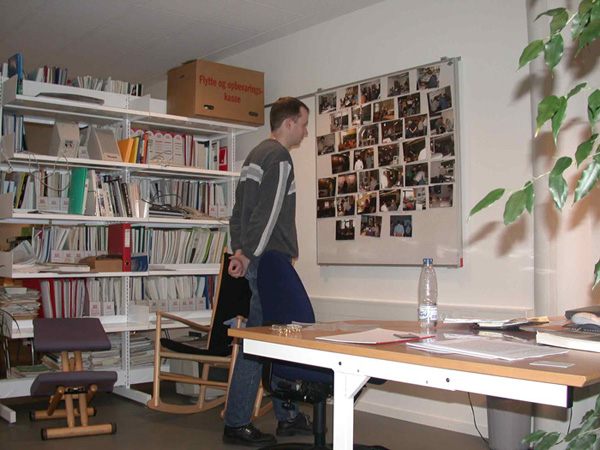
Illustration 1: The photographs were displayed on a board in our collaborative office environment a week before the collaborative
analysis took place. Research colleagues from within the office environment looked at the photographs during the week, became
familiar with them and some even started to discuss them. [14]
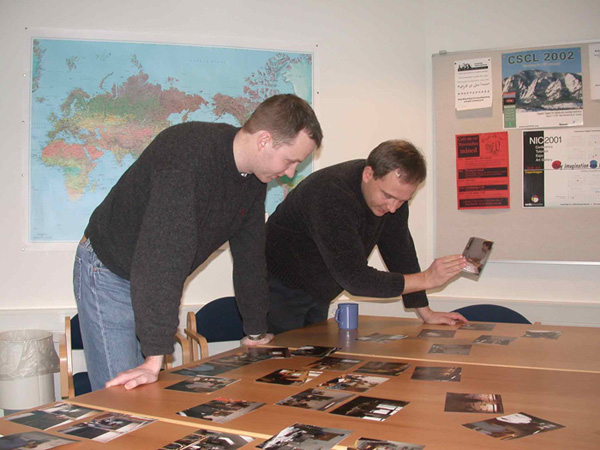
Illustration 2: During the collaborative analysis, the photographs were distributed on a table. The participants looked at
them, grouped them, re-grouped them, took a closer look at them, etc. During an ongoing discussion and this physical touching
and moving the photographs around, an analysis was carried out. [15]
Setting the stage for the collaborative analysis, the photographs were distributed randomly on a table. I explained to my colleagues my research aim of getting an overview of the work practices and the use of technology within the displayed work practices of the teachers, and my imageries about the two social spaces. It worked. Discussions, further look at the photographs, groupings of the photographs, re-groupings of the photographs, closer look, etc. started. The following sums up the results of the collaborative analysis of the photographs. [16]
4.1.1 Social spaces in the work practices of teachers
Are there two social spaces, a front and a back stage, in the teacher work practices? Looking at the photographs my colleagues argued against my division of the work practices of teachers into these two stages. Instead, they grouped the photographs into three: 1) the teacher working alone (a category seen in photographs with teachers alone for instance in front of a computer), 2) the teacher working with students (a category seen in photographs with teachers and students) and 3) the teacher working with colleagues (a category seen in photographs showing teachers talking with each other). This grouping made me wonder if there are several types of fronts and backs. The teacher working individually being the "real" back stage, the teacher working with students being the "real" front stage, and the teacher working with colleagues being a space in between? [17]
After taking a closer look at the photographs, the participants pointed out that the concepts of front and back stage are not adequate because the teacher can be part of the same type of practice at both the front and the back stage. An example from the discussion is visualized in the photographs below.
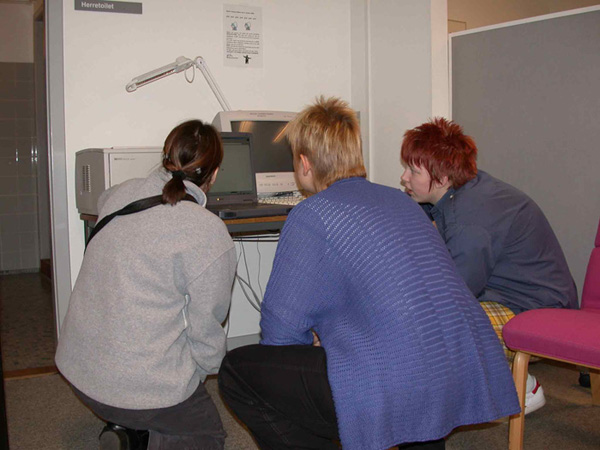
Illustration 3 displays the teacher in what my own analysis saw as the teachers' work at the front stage, interacting with
student. [18]
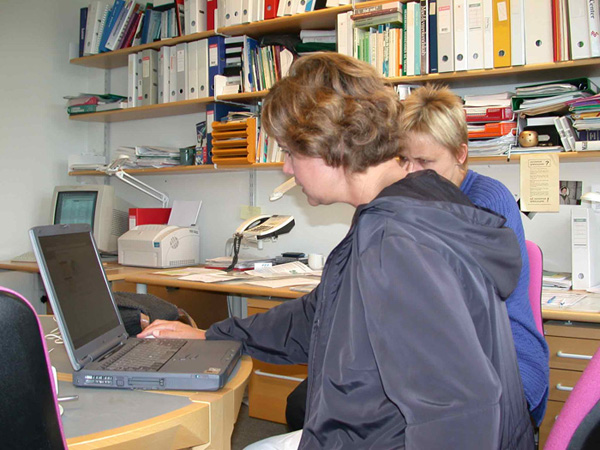
Illustration 4 shows the teacher in what my own analysis saw as work at the back stage, interacting with a colleague. [19]
Looking at the photographs again with my colleagues made me realize that what we actually did see here was the teacher doing exactly the same thing, namely guiding another person at the computer. In this way, the teacher is performing front stage in both situations, and the idea of a back stage as a place where the students are not present collapses. "But ...", a colleague remarked, "... this is only our interpretation on the basis of looking at these photographs. We do not know in which way the teacher experiences the situations. Maybe she experience the situations as both front and back stage?" The discussion about front and back stages in the work practices of teachers ended with questions rather than answers. [20]
4.1.2 Performance control at the social stages
On examining the grouping of the photographs into 1) teachers working individually, 2) teachers working with students and 3) teachers working with colleagues, a colleague noticed that there was a difference between the photographs in the group of teachers working with students and the other two groups. The photographs with the teachers and the students display how teachers make certain gestures, which put them in control of the situation. There are photographs where the teacher is positioned in the front of the classroom at a teacher's desk or at the black board, or photographs of teachers and students at a computer showing the teacher's hand controlling the computer mouse. We looked at all the photographs in this group and were surprised to find that it was true. Is it because it is nice to have control of situations in general? However, looking at the photographs in the group of teachers working with colleagues there was no sign of the teacher trying to take over control of for instance the computer or the space. Why did the teachers act so differently when being with students? Maybe this did indicate a division into front and back stages, acting controlled, or "performing" as GOFFMAN would say, at the front stage, and acting in relation to this performance although differently at the back stage. [21]
4.2.1 Making the technology visible
"If these photographs are supposed to visualize the technology in the work practices of teachers, I find the technology quite invisible with one exception where portable computers are seen everywhere". This remark from one of the colleagues tuned us into looking for the technology and we started grouping the photographs all over again. Still following the three categories 1) the teacher working individually, 2) the teacher working with students and 3) the teacher working with colleagues, we found technology present primarily within the category: teacher working with students. [22]
However, within this discussion, a question of what we could actually see in the photographs was raised. A photograph like Illustration 5 shows a teacher working alone in front of a computer. But is he working alone or is he collaborating virtually with students or colleagues?
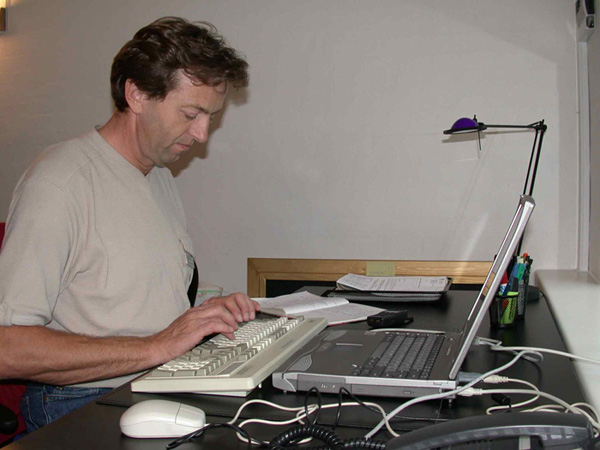
Illustration 5: Is the teacher on-line or off-line? Alone or collaborating? Technology raises questions as to whether what
appears to be obvious is in fact the reality. [23]
4.2.2 Taking a closer look at the use of technology
Taking a closer look at the photographs in the group "teachers working with students" a participant argued that if we looked for technology in a broad sense, i.e. both computers, blackboards, books and other artifacts used by the teachers, the role of the computer could be questioned. "Is the computer merely a new form of blackboard?" he asked. We noticed that, within this category, we could group the photographs into two groups: 1) photographs where the computer was present and 2) photographs where a blackboard was present. This may seem uninteresting but it indicated that the use of technology, in terms of computers, was either or, and not both. Why was that? A discussion started about the ways in which the understanding of technology has consequences for its use but provided no answers from the analysis of the photographs. [24]
4.2.3 Identifying premises between teachers and technology
"I understand, however, through looking at the photographs of teachers and students around a computer, why computers are not used more frequently in classroom teaching. It looks very uncomfortable for the teacher. Either the teacher is awkwardly stooping over the computer and the student or the teacher is squeezed into a corner next to the student and the computer."
This comment from one of the colleagues made us discuss how the photographs pictured situations where more than one person is placed around a personal computer and that this type of work could not go on for many hours. It would simply be too physically demanding for the teachers. In this way, the photographs showed how work with and around technology was carried out on the premises of the technology. Because of this teachers using the technology look strained. Why is that and what consequences do these technological premises have for the use of technology within the work practices of teachers, we asked but again found only questions, not answers, in the photographs. [25]
As seen above, the collaborative analysis resulted in more questions than answers. This fact was contemplated during the analysis through both specific and general discussions about what we could actually see in the photographs. Examples from this discussion are shown in the above Illustrations 3, 4 and 5. Other examples are seen below. Illustration 6 shows a person who is placed in the front of the room, the other persons in the photograph are looking at him, and the participants all look the same age. Illustration 7 shows eight people gathered around a table, they are looking mainly in the same direction and one is raising her hand. Also the participants in this photograph look as if they are of the same age. Who is the teacher in the two photographs? In Illustration 6 you might not have any doubts but what about Illustration 7?
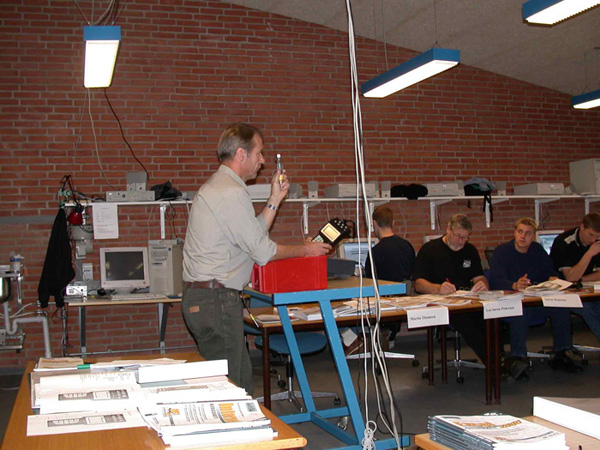
Illustration 6: Who is the teacher? [26]
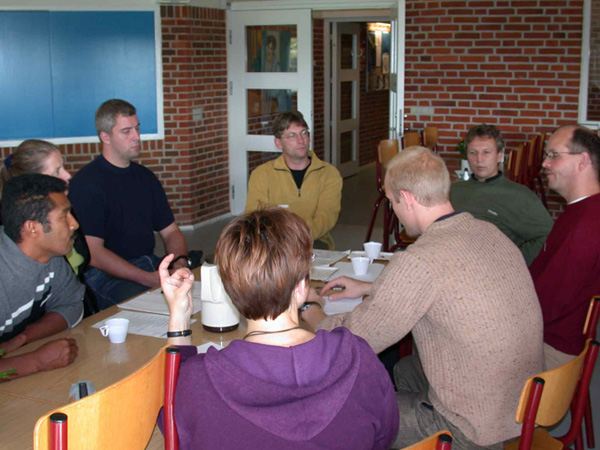
Illustration 7: Who is the teacher? Photographic data needs an ethnographic background. [27]
The above illustrations indicate the difficulties in analyzing photographs as the only data material as suggested by COLLIER and COLLIER (1986). All the persons in Illustration 7 are teachers discussing with each other, but how could you know that unless you were there or had more information about the situation. Accordingly, photographs must, as JORDAN and HENDERSON remark regarding their visual video data, be used in relation to an ethnographic background (1995, p.43). [28]
During the collaborative analysis, I often answered questions from my colleagues informing them about who the photographs portrayed and what was going on in the photographs. I had my background understanding from my 15 observations that made me contextualize the situation of the photographs in one way. My colleagues' lack of background understanding caused problems in some cases but it also made them see things in the photographs that I did not see. [29]
Looking at the issues arising from the collaborative analysis leaves us with the question: Can we actually study work practices by collecting and analyzing photographs? This study showed that we can see traces of work practices in photographs. The photographic analysis has started to shade my imagery of the teachers' work practices as two social spaces; a front and a back stage. Three groups of work practices appeared during the collaborative analysis indicating that there might be spaces in between the front and the back stage, and that the concepts of front and back stage are not adequate. In other words, front stages can occur in back stages, etc. On the basis of these observations, the photographs have made me consider my spatial imagery about work practices and left me with an understanding of practices in more fluid and situational terms that cross social spaces. The study also showed not only where the technology is in use in the work practices of teachers but also indicated how the technology is used in the work practices and on whose premises it is used. These indications result in a consideration of how the teachers' understanding of technology has consequences for its use. In this way, the study fulfilled its empirical purpose starting to shade my imageries of the work practices, indicating where to look for technology within these work practices, and leaving further questions to deal with in following field studies. Especially the fact that photographs seem to raise questions rather than provide answers is valuable for the beginning of a field study like this, but should also make the reader consider where this type of data collection and analysis is used within a study. [30]
This small photographic study suggests several methodological practices that might prove useful. It has shown how data collection with a camera can be very disturbing to the situation observed. This disturbance means that the use of the camera in the field should be considered very carefully, but also that training the observer to use the camera either in a less disturbing manner, or as suggested by HARPER (1987) "... in a forthright and even aggressive manner" (p.10), is an important part of the use of this technology in qualitative research. In spite of these difficulties, the use of photography also demonstrated its potential. The limitations of the camera lens sharpened my observations for social spaces and made me see social spaces in a more nuanced way. The photographs also opened up issues for interpretations and discussions during the collaborative analysis. Here, the opportunity to share data with colleagues was efficient, especially as it challenged my imageries and first interpretations of the photographs. [31]
The openness of photography to interpretation, however, indicated problems with the idea of using photography as an isolated method for both data collection and analysis. Examples in this article show how an ethnographic background is necessary for understanding what goes on in a photograph. Moreover, as HAMMERSLEY and ATKINSON warn, an overemphasis on technological recordings, in this case photography, "... can distort one's sense of 'the field', by focusing data collection on what can be recorded ..." (1995, p.187). The distortion of my sense of the field can be seen in several ways through this study: The fact that I was not allowed to shoot photographs during all observations. The fact that the disturbance of the "click" from the camera made me avoid taking photographs in several situations, and the fact that many parts of the work practices of teachers are still undiscovered in this photographic study because it was not possible for me to enter the spaces where the more invisible back stage practices took place. Information about this more invisible part of the work practices of teachers is to be found in my field notes from conversations with teachers and in the interviews with the teachers. In this way, the photographic study ends with questions whose answers are to be found in the related data material and further field studies. [32]
Ball, Michael S. & Smith, Gregory W.H. (1992). Analyzing Visual Data. London: Sage.
Banks, Marcus & Morphy, Howard (Eds.) (1997). Rethinking Visual Anthropology. New Haven: Yale University Press.
Bateson, Gregory & Mead, Margaret (1942). Balinese character: A photographic analysis. New York: New York Academy of Sciences.
Becker, Howard S. (1998). Tricks of the Trade—How to Think about Your Research While You're Doing It. Chicago: The University of Chicago Press.
Collier, John Jr. (1995). Photography and Visual Anthropology. In Paul Hockings (Ed.), Principles of Visual Anthropology (pp.235-254). Berlin: Mouton de Gruyter.
Collier, John Jr. & Collier, Malcolm (1986). Visual Anthropology—Photography as a Research Method. Albuquerque: University of New Mexico Press.
Goffman, Erving (1959). The Presentation of Self in Everyday Life. London: Penguin Books.
Goodwin, Charles & Goodwin, Marjorie Harness (1998). Seeing as a situated activity: formulating planes. In Yrjö Engeström & David Middleton (Eds.), Cognition and Communication at Work (pp.61-95). Cambridge: Cambridge University Press.
Hammersley, Martyn & Atkinson, Paul (1995). Ethnography—Principles in Practice. London: Routledge.
Harper, Douglas (1987). Working Knowledge—Skill and Community in a Small Shop. Chicago: The University of Chicago Press.
Harper, Douglas (1994). On the Authority of Image—Visual Methods at the Crossroads. In Norman K. Denzin & Yvonna S. Lincoln (Eds.), Handbook of Qualitative Research (pp.403-412). Thousand Oaks: Sage.
Heath, Christian & Luff, Paul (2000). Technology in Action. Cambridge: Cambridge University Press.
Hockings, Paul (Ed.) (1995). Principles of Visual Anthropology. Berlin: Mouton de Gruyter.
Jordan, Brigitte (1993). Ethnographic Workplace Studies and Computer Supported Cooperative Work. Proceedings of the Interdisciplinary Workshop on Informatics and Psychology, Schärding, Austria.
Jordan, Brigitte & Henderson, Austin (1995). Interaction Analysis: Foundations and Practice. The Journal of the Learning Sciences, 4(1), 39-103.
Luff, Paul; Hindmarsh, Jon & Heath, Christian (Eds.) (2000). Workplace Studies—Recovering Work Practice and Informing System Design. Cambridge: Cambridge University Press.
Mead, Margaret (1995). Visual Anthropology in a Discipline of Words. In Paul Hockings (Ed.), Principles of Visual Anthropology (pp.3-10). Berlin: Mouton de Gruyter.
Ruhleder, Karen & Jordan, Brigitte (1997). Capturing Complex, Distributed Activities: Video-Based Interaction Analysis as a Component of Workplace Ethnography. IFIP WG 8.2 Working Conference: Information Systems and Qualitative Research.
Star, Susan Leigh & Strauss, Anselm (1999). Layers of Silence, Areas of Voice: The Ecology of Visible and Invisible work. Computer Supported Cooperative Work, 8, 9-30.
Suchman, Lucy A. (1998). Constituting shared workspaces. In Yrjö Engeström & David Middleton (Eds.), Cognition and Communication at Work (pp.35-60). Cambridge: Cambridge University Press.
Suchman, Lucy A. (1995). Making Work Visible. Communications of the Acm, 38(9), 56-64.
Anne Marie KANSTRUP is a Ph.D candidate at the Institute of Communication at Aalborg University, Denmark (http://www.hum.auc.dk/index.uk.html), connected to the postgraduate research school Human Centered Informatics (http://www.hci.hum.auc.dk). Her research interests include design and use of technology, workplace studies, learning and, as shown in this article, the use and development of qualitative methods to improve dialogue in research.
Contact:
Anne Marie Kanstrup
Aalborg University
Kroghstraede 3
9220 Aalborg East
Denmark
Phone: (+45) 96 35 80 80
E-mail: amk@hum.auc.dk
Kanstrup, Anne Marie (2002). Picture the Practice—Using Photography to Explore Use of Technology Within Teachers' Work Practices [32 paragraphs]. Forum Qualitative Sozialforschung / Forum: Qualitative Social Research, 3(2), Art. 17, http://nbn-resolving.de/urn:nbn:de:0114-fqs0202177.